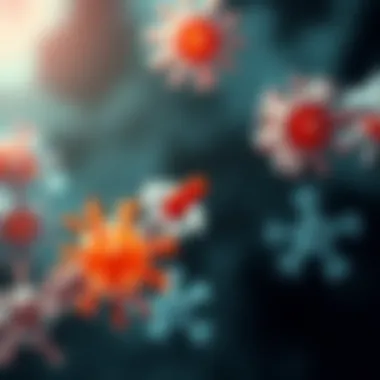Exploring the Role and Impact of Protease Inhibitors


Overview of Research Topic
Brief Background and Context
Protease inhibitors represent a class of compounds that have gained significant attention in the fields of biochemistry and pharmacology. These molecules, primarily designed to inhibit proteases – enzymes responsible for protein degradation – play a vital role in various biological processes. Proteases are involved in numerous physiological functions, including cell signaling, immune response, and protein recycling. When these enzymes malfunction, it can lead to serious health issues, including viral infections and certain types of cancers. As medicinal chemistry continues to advance, the design and implementation of protease inhibitors have become critical in developing therapeutic agents that target these life-threatening conditions.
Understanding the structure and function of proteases is crucial for developing effective inhibitors. The structural diversity of proteases allows for a variety of inhibition mechanisms, making it an exciting area for scientific research. This article will delve deep into the intricacies of protease inhibitors, laying the groundwork for understanding their role and potential in modern medicine.
Importance in Current Scientific Landscape
In the current landscape of drug discovery and development, protease inhibitors have carved out an important niche. Their significance is underscored by their application in treating major diseases, particularly in the treatment of HIV and hepatitis C, as well as in oncology, where they are being investigated for their capacity to disrupt cancer cell proliferation. As scientists seek more targeted options for therapy, protease inhibitors may provide avenues that traditional methods haven’t explored, making it imperative to expand upon the foundational understandings of these compounds.
Through ongoing research, these inhibitors not only enhance our ability to treat existing diseases but also prompt a reevaluation of the future of therapeutic approaches. With increasing resistance to established drugs and the need for innovative solutions, protease inhibitors are thrust into the spotlight, urging the scientific community to further innovate and explore.
Methodology
Research Design and Approach
The approach taken to investigate protease inhibitors encompasses a multidimensional route. It combines bioinformatics for selecting promising candidates based on active site characteristics, structural biology employing crystallography for in-depth analysis, and extensive in vitro studies assessing compound efficacy against target proteases. This layered methodology allows researchers a comprehensive view of how inhibitors interact at a molecular level, thus informing further development.
Data Collection Techniques
Data collection in protease inhibitor research draws from various experimental techniques including but not limited to:
- X-ray Crystallography: For understanding the structural binding of inhibitors to proteases.
- High-Throughput Screening: For evaluating a large number of compounds in a systematic fashion to identify potential leads.
- Kinetic Studies: To measure the rate of enzyme inhibition and characterize binding dynamics.
- In Vivo Studies: Investigating the efficacy and safety of these inhibitors within biological systems.
Through these techniques, researchers parse through vast datasets to unravel both the mechanisms by which protease inhibitors act and how they can be applied effectively in medical treatments.
"The delicate balance between enzyme activity and inhibitor presence is what drives new frontiers in therapeutic agent development."
This narrative will unfold further, exploring not just the intricacies of the chemical interactions involved but also shedding light on the potential implications for future research and the horizon of drug development.
Intro to Protease Inhibitors
Protease inhibitors sit at a crossroads of biochemistry and medicine, playing a critical role in treatment strategies for a multitude of diseases. Understanding their functions, history, and classifications can offer significant insights into their importance in modern pharmacology. These compounds, primarily known for their ability to regulate or inhibit the function of proteases, are essential to a variety of therapeutic contexts, most notably in combating viral infections and certain forms of cancer.
Definition and Role
Protease inhibitors are molecules that specifically interfere with the activity of proteases, a class of enzymes responsible for breaking down proteins. These inhibitors can either block the active sites of these enzymes or prevent their activation, halting the essential processes of protein degradation. This is key for many physiological and pathological processes. For instance, in viral infections such as HIV, protease inhibitors prevent the maturation of viral proteins, thus curtailing the virus's ability to reproduce.
In addition to their role in virology, protease inhibitors are also crucial in cancer treatment, where they can help regulate pathways that facilitate tumor growth. Their mechanisms of either suppression or modulation can lead to significant therapeutic outcomes. In particular contexts, the balance of protein degradation and synthesis can influence disease progression; thus, protease inhibitors become valuable tools in the ongoing fight against diseases that presently burden global health systems.
Historical Context
The journey of protease inhibitors spans several decades, with roots tracing back to early research on proteins and enzymes. The discovery of the first inhibitor, originally derived from natural sources like plants and animals, sent ripples through pharmaceutical development. Researchers in the 1980s and 1990s began to unlock the potential of these compounds in fighting diseases such as HIV/AIDS, leading to a revolution in antiviral therapy.
The advent of highly active antiretroviral therapy (HAART) propelled protease inhibitors to the forefront of treatments. While drugs like Ritonavir and Saquinavir marked notable advancements in efficacy, they also threw light on the challenges of resistance. Over time, this led to a deeper exploration of both natural and synthetic inhibitors, spurring immense interest in their structural variations and mechanisms of action.
In summary, the historical context of protease inhibitors not only showcases their scientific evolution but also highlights the burgeoning need for continued research. The link between basic scientific discoveries and their clinical implications continues to be an area ripe for exploration, demanding a nuanced understanding of both their mechanics and their applications.
Classification of Protease Inhibitors
Understanding the classification of protease inhibitors is fundamental in the study of their functionality and applications. By categorizing these inhibitors, researchers can better analyze their mechanisms, therapeutic uses, and potential effects on human health. Moreover, distinctions between natural and synthetic protease inhibitors play a crucial role when developing new drugs and therapeutic strategies. Knowing how different classes function can engender more effective treatments, particularly in combating diseases like cancer and viral infections.
Natural Protease Inhibitors
Natural protease inhibitors are derived from biological sources and play pivotal roles in regulating proteolytic enzymes in various organisms. These inhibitors are frequently encountered in plants, animals, and microorganisms. For example, a well-known natural inhibitor is soybean trypsin inhibitor, which serves as a defense mechanism in plants against herbivores. Another example is α1-antitrypsin, a protein found in human plasma that protects tissues from enzymes of inflammatory cells, particularly during acute inflammation.
Natural inhibitors are often characterized by their specificity; they tend to target specific proteases, thus minimizing off-target effects. Furthermore, they often boast a unique structural architecture that can be beneficial when designing synthetic analogs or mimetics. However, the limitations of natural inhibitors include variability in extraction yields, potential immunogenic responses when used therapeutically, and the need for extensive purification processes.
Synthetic Protease Inhibitors
Synthetic protease inhibitors are man-made compounds designed to mimic or enhance the function of natural inhibitors. The advent of synthetic biology and advanced organic chemistry has paved the way for the creation of these inhibitors, which have become vital in therapeutic contexts. Noteworthy examples include ritonavir and lopinavir, both used in the treatment of HIV, showcasing that synthetic efforts can lead to highly effective antiviral drugs.
One of the significant advantages of synthetic inhibitors is their potential for fine-tuning. Chemists can modify their structures for optimized binding affinities, pharmacokinetics, and selectivity against target proteases. For instance, the design of a peptidomimetic inhibitor allows for tweaked active sites to better fit specific proteases, enhancing efficacy while reducing side effects.


However, the realm of synthetic inhibitors is not without challenges. Issues such as toxic side effects, potential resistance development, and complex regulations regarding drug approval can complicate the development process. Furthermore, while synthetic compounds often showcase high efficacy in vitro, translating that efficacy to in vivo scenarios can be tricky due to biological variabilities.
In summary, synthetic protease inhibitors serve as a testament to human ingenuity in tackling medical challenges. Detailed understanding and ongoing research into their design and mechanisms hold promise for developing next-generation therapeutics.
Mechanisms of Action
Understanding the mechanisms of action of protease inhibitors is pivotal in recognizing how these compounds exert their effects against various diseases. By inhibiting the activity of proteases, which play essential roles in protein processing and maturation, these inhibitors can profoundly alter the course of viral infections and certain cancers. This section delves into the intricate details of how these inhibitors bind to proteases and the subsequent inhibition pathways they engage in, which are crucial for anyone invested in pharmacology or related fields.
Binding Dynamics
The binding dynamics of protease inhibitors are crucial for their efficacy. These inhibitors typically bind to the active sites of proteases, preventing substrate access. This process can be thought of as a lock and key mechanism—where the inhibitor serves as the key that fits snugly into the protease's lock. The strength of this binding relies on various factors, such as the chemical structure of the inhibitor and the specificities of the protease.
An interesting aspect is how modifications in the inhibitor's structure can lead to varying affinities. For instance, a subtle change in a functional group can enhance binding through better interactions with the protease’s active site, making the inhibitor more effective. In turn, this affinity translates to a more pronounced therapeutic effect. Moreover, allosteric binding—where the inhibitor attaches to a site other than the active site—can modulate protease activity without directly blocking substrate binding.
"The relationship between inhibitors and proteases is akin to a dance; the more synchronized they are, the smoother the inhibition process."
The kinetics of binding can also influence the design of these inhibitors. Fast-on/fast-off inhibitors may offer quick action, but they can be less effective in sustaining inhibition. On the other hand, slow-on/fast-off inhibitors can provide prolonged effects but could risk saturating the system with side effects. It is this balance that researchers must navigate tirelessly in protease inhibitor design.
Inhibition Pathways
Once a protease inhibitor successfully binds to its target, it initiates a cascade of effects that culminate in the inhibition of protein degradation. The inhibition pathways vary depending on the protease being targeted and the nature of the inhibitor. For instance, in viral proteases like those found in HIV or HCV, the inhibition leads to stalled viral replication—thus providing a therapeutic window for patient recovery.
Researchers have categorized inhibition into competitive and non-competitive types. In competitive inhibition, the inhibitor competes directly with the substrate for the active site, while in non-competitive inhibition, it binds to an alternate site, altering the protease's function without obstructing substrate binding directly.
Moreover, there's growing interest in understanding how these inhibitors can work synergistically. For example, when used in combination therapies—where two or more inhibitors target different pathways—the therapeutic outcomes can be significantly enhanced. This is essential in tackling complex diseases like cancer, where multiple dysregulated pathways may be at play.
In summary, the mechanisms of action associated with protease inhibitors are multifaceted. They hinge on the inhibitor's binding dynamics and the nature of the inhibition pathways deployed against specific targets. A comprehensive grasp of these mechanisms is indispensable for anyone involved in drug development and disease treatment, as it not only informs efficacy but also aids in predicting and circumventing resistance—a major challenge faced in therapeutic settings.
Therapeutic Applications
The therapeutic applications of protease inhibitors play a crucial role in modern medicine, particularly in combating viral infections and managing various types of cancer. By providing insight into how these inhibitors operate in clinical settings, we can appreciate their significance in treatment protocols. From the eradication of viral pathogens to the modulation of tumor growth, protease inhibitors are a pillar of therapeutic strategies that deserve detailed exploration.
HIV and Antiviral Therapies
HIV treatment has come a long way, notably due to the emergence of protease inhibitors. Drugs such as Ritonavir and Saquinavir have been crucial in managing HIV, aiming to block the virus's proteases, enzymes vital for viral replication. By inhibiting these enzymes, protease inhibitors limit viral load in patients, turning what was once a death sentence into a manageable chronic condition.
"Protease inhibitors have transformed HIV treatment, helping countless individuals maintain a good quality of life."
The effectiveness of these treatments in combination with other antiretroviral therapies has given rise to what is known as Highly Active Antiretroviral Therapy (HAART). It's essential to note that while these medications reduce the virus's ability to replicate, they may also have side effects. Monitoring and managing these side effects is crucial to ensure patient adherence and overall health.
Cancer Treatment
Protease inhibitors also hold promise beyond the realm of viral infections, particularly in the field of oncology. Some cancers have shown susceptibility to these inhibitors due to their role in regulating cell division and apoptosis (programmed cell death). For instance, Bortezomib, utilized in multiple myeloma treatment, is a proteasome inhibitor that prevents unwanted protein breakdown, leading to a buildup of proteins that can promote cancer cell death.
- Examples of Protease Inhibitors in Cancer
- Bortezomib
- Carfilzomib
By targeting unique aspects of cancer cells' biology, these inhibitors not only help in shrinking tumors but may also improve the effectiveness of existing therapies. However, the variability in how patients respond to treatments calls for personalized strategies to maximize efficacy while minimizing adverse effects.
Autoimmune Disorders
Autoimmune disorders arise when the immune system mistakenly attacks healthy cells, and protease inhibitors have started to exhibit potential in modulating immune responses. For instance, some studies suggest that protease inhibitors can regulate inflammatory pathways, easing symptoms in conditions like rheumatoid arthritis and systemic lupus erythematosus.
- Potential Benefits
- Reduction in inflammatory responses
- Improvement in symptom management
Research is still in its infancy, and the findings are promising but require extensive validation. As we push the envelope in understanding the immunological effects of protease inhibitors, we may find new ways to treat these complex disorders effectively.
In summary, the therapeutic applications of protease inhibitors are vast and varied, striking at the heart of diseases that have plagued humanity for years. As researchers continue to uncover their potential, we move closer to improved treatment strategies that could change the landscape of healthcare.
Structural Diversity of Protease Inhibitors
The structural diversity of protease inhibitors is a pivotal topic within the study of biochemistry and pharmacology. Understanding the variation in structures among these inhibitors not only sheds light on their functionality but also paves the way for novel therapeutic strategies. The complexity in their architecture can significantly influence how they interact with specific proteases, which in turn determines their efficacy. Grasping this diversity allows researchers and clinicians to tailor treatments for various diseases, particularly those involving viral infections and cancers.
Common Structural Features


Many protease inhibitors share common structural features that are crucial for their activity. One notable characteristic is the presence of specific binding motifs that facilitate interaction with the active sites of proteases.
- Peptide Bonds: Several inhibitors mimic peptide substrates, allowing for competitive inhibition.
- Hydrophobic Pockets: These regions often stabilize the inhibitor-protease complex, enhancing binding affinity.
- Functional Groups: Groups like hydroxyl, carboxyl, and amine play critical roles in stabilizing interactions through hydrogen bonds and electrostatic forces.
These shared elements suggest a fundamental blueprint that many effective inhibitors adhere to, yet there is substantial variation in how these features are arranged and functionally interpreted across different classes of protease inhibitors.
Variability Among Different Classes
The variability among protease inhibitor classes showcases an intriguing aspect of their diversity. Each class demonstrates unique structural attributes that cater to its target protease family. For instance, some chemical families exhibit distinct backbone structures:
- Serine Protease Inhibitors: Often characterized by their serine residue in the active site, these inhibitors employ a dipeptide backbone with various substitutions to enhance selectivity. They also tend to adopt a compact form that fits snugly into the active site.
- Cysteine Protease Inhibitors: These typically incorporate reactive electrophilic groups that form covalent bonds with the cysteine residue in the target protease, leading to irreversible inhibition.
- Asparagine Protease Inhibitors: Classically structured to mimic natural substrates, these inhibitors tend to balance between flexibility and rigidity, adapting efficiently to the protease's active site while offering enough stability to remain functional in challenging biological environments.
By analyzing the structural variability among these classes, researchers can harness specific features for designing novel inhibitors that are both effective and safe. Considerations like solubility, bioavailability, and selective targeting are all enriched by the insights provided by this structural exploration.
Synthesis and Development Challenges
The craft of synthesizing protease inhibitors is more than just a technical feat; it is a complex venture loaded with myriad challenges at every turn. Understanding these challenges is crucial for advancing the field of medicinal chemistry and ensuring that these vital compounds fulfill their potential in therapeutic settings. Synthesis and development challenges can significantly influence the timelines of drug discovery, the viability of compounds, and ultimately, patient access to effective treatments. These challenges can be grouped into two primary categories: synthetic pathways and regulatory hurdles, each presenting its own set of intricacies and implications.
Synthetic Pathways
Creating protease inhibitors often begins with the need to develop synthetic pathways that are both efficient and scalable. This means that researchers must find the right blend of cost-effectiveness and innovation to produce viable compounds that can transition smoothly from the lab bench to clinical trials. The complexity of protease structures can demand intricate multi-step reactions that don't always yield the desired product on the first, or even the second or third, attempt.
Synthetic routes can vary widely depending on factors like the target protease, whether the inhibitor is natural or synthetic, and the functional groups involved. For example, the synthesis of peptidomimetics—molecules resembling peptides—often requires strategic alterations in their backbone structures to enhance stability and bioavailability. Notably, synthetic challenges may involve issues like:
- Selectivity: Ensuring that the inhibitor specifically targets the desired protease without affecting other enzymes.
- Yield: Achieving satisfactory yields in a cost-effective manner remains a significant hurdle.
- Purity: Maintaining the purity of synthesized compounds is paramount, as impurities can lead to unexpected behaviors and toxicities.
The ability to overcome these syntactic obstacles can greatly influence the eventual therapeutic efficacy of a protease inhibitor.
Regulatory Hurdles
Once a potential protease inhibitor is synthesized, the path through regulatory approval can feel like running a marathon with no finish line in sight. Drug development is heavily regulated to ensure safety, efficacy, and quality before public release. Navigating these regulatory hurdles requires not only scientific ingenuity but also a deep understanding of the regulatory frameworks governing clinical trials and marketing approvals. Complications might arise from:
- Documentation Requirements: Every stage requires thorough documentation, from initial lab findings to clinical trial results. This process can be overwhelmingly meticulous.
- Approval Timelines: Regulatory reviews can take considerable time, extending development antiquities, which can stall the arrival of life-saving treatments.
- Compliance: Companies must make sure their processes meet stringent Good Manufacturing Practices (GMP), complicating manufacturing efforts.
Overcoming these hurdles is not merely about proving that a compound works; it’s about crafting a comprehensive narrative that addresses a panel of experts who scrutinize everything from safety profiles to ethical considerations in trial methodologies.
The intertwining of effective synthesis and stringent regulatory oversight is a delicate balancing act. Successful navigation of these challenges is essential, not just for the scientists conducting the research but for the patients who ultimately rely on these inhibitors for therapeutic relief.
Emerging Trends in Research
The field of protease inhibitors is currently experiencing a surge of innovative research and application, underscoring their critical role in biochemistry and medicine. Emerging trends reveal a shift towards more targeted therapies and a deeper understanding of protease dynamics. This new wave of research is not just about developing new drugs; it’s about rethinking how existing inhibitors can be utilized in novel ways. As researchers navigate this terrain, key elements come into play, including the identification of novel inhibitors, combination therapies, and patient-centric approaches.
Novel Inhibitors
In the quest for more effective treatments, scientists are zeroing in on novel protease inhibitors that can overcome existing limitations. For instance, rather than relying solely on traditional methods of inhibition, the discovery of allosteric inhibitors has the potential to refine therapeutic strategies. Allosteric sites are distinct from the active site, which allows these inhibitors to modulate enzyme activity without directly blocking substrate binding. This mechanism offers the promise of fewer side effects and better patient outcomes.
Some recent research has also unveiled inhibitors derived from unconventional sources, such as natural compounds from marine organisms. These marine proteases display unique characteristics that could revolutionize how we approach the treatment of complex diseases. By expanding the search radius beyond common sources, researchers aim to unveil a treasure trove of inhibitory compounds that could lead to breakthroughs in areas like cancer and infectious diseases.
"Harnessing nature’s diversity provides a pathway to discovery that may reshape our treatment landscape."
- Insights from a research publication on novel inhibitor discovery.
Combination Therapies
Combining therapies is quickly emerging as a key strategy in maximizing the effectiveness of protease inhibitors. The rationale is straightforward: diseases, especially chronic conditions like cancer and HIV, often involve multifactorial processes that can’t be addressed by a single drug. Thus, a cocktail approach could target multiple pathways simultaneously, increasing efficacy and hinder the development of resistance.
For instance, the synergy observed when protease inhibitors are paired with other antiviral agents highlights this trend. Researchers have found that integrating protease inhibitors with nucleoside reverse transcriptase inhibitors (NRTIs) enhances overall therapeutic efficacy in HIV treatment protocols. This kind of strategic pairing not only improves treatment outcomes but also significantly lowers viral loads in patients.
Moreover, combination therapies can reduce the likelihood of resistance developing. When multiple angles are attacked, it’s harder for the virus or cancer cells to adapt and survive. As more data comes in, the clinical landscape will shift towards personalized medicine, where treatment regimens are tailored to the patient’s unique genetic profile and the specifics of their condition.
Through these emerging trends, protease inhibitors are set to make a profound impact. Their evolution from basic biochemical tools to sophisticated therapeutic agents capable of addressing complex medical conditions is nothing short of remarkable.
Comparison of Protease Inhibitors
In the realm of therapeutic applications, the comparison of protease inhibitors stands as a fundamental topic. Understanding these differences not only aids in developing targeted therapies but also provides insights into patient outcomes. The multifaceted nature of protease inhibitors means that their efficacy, safety, and overall impact can vary significantly. Hence, this section delves into key attributes that define their roles in modern medicine.
Efficacy and Safety Profiles


When evaluating protease inhibitors, assessing their efficacy is paramount. Efficacy refers to how well a drug achieves its intended effect under ideal conditions. Each class of protease inhibitors exhibits varied mechanisms that directly influence their therapeutic outcomes. For example, protease inhibitors like Saquinavir and Lopinavir, used in HIV treatment, demonstrate robust viral load reduction, effectively suppressing the virus. Notably, however, efficacy might waver depending on specific patient populations and co-existing conditions.
In contrast to efficacy, safety profiles are equally critical. Side effects can range from mild to severe, influencing patient compliance and overall health quality. The safety of a particular protease inhibitor is often assessed through clinical trials, but these profiles can expand in real-world scenarios. The recent emergence of new inhibitors presents novel safety data that need close monitoring as they enter widespread clinical use.
Examples of potential side effects include:
- Nausea and diarrhea
- Liver enzyme elevations
- Cardiovascular risk factors
Liquidity in these dynamics is crucial. Thus, a well-rounded comparison not only looks at how effective a drug might be but equally prioritizes understanding its safety in diverse patient scenarios.
Cost-Effectiveness Considerations
The economic landscape surrounding protease inhibitors forms another layer in their comparison. Cost-effectiveness is a leading consideration, particularly for healthcare providers and policymakers. In today’s healthcare environment, many factors come into play when evaluating the cost-effectiveness of a treatment, including:
- Drug Acquisition Costs: The price of protease inhibitors can differ widely across classes and manufacturers. For instance, Darunavir may have a higher price tag compared to older compounds, yet it often justifies its cost with superior efficacy and a favorable safety profile.
- Adherence and Outcomes: The effectiveness of any treatment is often linked to how well patients stick to their medication regimen. Non-adherence can lead to treatment failures, thus increasing overall healthcare costs and the burden on healthcare systems.
- Long-Term Savings: Investing in more effective protease inhibitors might lead to significant savings down the line through reduced hospitalizations and complications. This long-term view is essential for evaluating overall cost-effectiveness.
A cost-benefit analysis must include both immediate expenses and the broader context of a patient’s health outcomes. The interplay between economic viability and therapeutic success thus represents a critical dimension in the effective implementation of protease inhibitors into standard healthcare practices.
"The best choice is often not the cheapest one. It's crucial to evaluate both the efficacy and the total cost of care, especially when it involves chronic conditions that require long-term treatment."
In summary, a thoughtful comparison of protease inhibitors encapsulates a range of factors that influence their application in clinical settings. From efficacy and safety profiles to cost-effectiveness, these elements shape the therapeutic landscape, guiding choices that can significantly affect patient care and treatment success.
Future Perspectives
As we peer into the future landscape of protease inhibitors, it becomes evident that the significance of this domain cannot be overstated. The advances in our understanding of these compounds come with a plethora of potential benefits, ranging from improved treatment protocols to novel therapeutic strategies. Future perspectives in the field illuminate not just the scientific avenues waiting to be explored but also the broader clinical implications regarding patient outcomes and drug accessibility.
A key aspect to focus on is the potential for innovations in the design of protease inhibitors. With the rise of personalized medicine, there is a growing potential to tailor inhibitors to fit the unique signatures of patient’s diseases. Researchers are diving into computational drug design, leveraging artificial intelligence to identify molecular patterns that predict the efficacy of specific inhibitors against various proteases. This data-driven approach not only accelerates the drug development process but also allows for the crafting of inhibitors that are more effective with minimal side effects.
Looking at the therapeutic landscape, targeting the right protease can open doors to treating previously unaddressed conditions. By isolating not just viral infections but also chronic diseases like Alzheimer's or Parkinson's, protease inhibitors may usher in a new era of pharmacological intervention. Specific innovations include:
- Targeted nanocarrier systems that deliver inhibitors directly to diseased tissues, enhancing efficacy and reducing systemic exposure.
- Biologics that utilize monoclonal antibodies designed to inhibit specific proteases with unparalleled precision.
Furthermore, an integrative approach could combine protease inhibitors with other therapeutic modalities, such as gene editing technologies like CRISPR, aiming at providing a multi-faceted treatment strategy. The exploration of combination therapies presents another frontier, with emerging evidence suggesting that synergistic effects could bolster treatment outcomes significantly.
"The future of protease inhibitors lies not only in their individual capabilities but in their ability to work harmoniously with other therapeutic agents."
Challenges in Implementation
While potential innovations shimmer on the horizon, the path is laden with substantial obstacles. Challenges in implementation range from the technical to the regulatory, shaping the feasibility of bringing novel protease inhibitors from the lab to the clinic. One primary concern is the complexity of clinical trials needed to assess new inhibitors' safety and efficacy. Designing robust studies that accurately reflect real-world conditions can be daunting.
Regulatory frameworks, though essential, often evolve slower than scientific advancements. This mismatch can create bottlenecks in bringing innovative therapies to market. As different countries uphold varying levels of scrutiny and approval lines, navigating these waters becomes increasingly complex for researchers and pharmaceutical companies alike.
Next, manufacturing challenges play a critical role in the practical adoption of new inhibitors. Ensuring consistent quality and scalability can be daunting, especially with biologics and novel synthetic compounds. Additionally, there is the pressing issue of cost-effectiveness. The economics of drug development often dictate whether new therapies are accessible to patients or get locked away in a research vault.
Integrating ethical considerations into these discussions cannot be overlooked. Access to treatment raises continually pressing questions. Not only should innovations be effective, but they must also be affordable and available to the populations most in need.
In summary, while potential innovations surrounding protease inhibitors offer significant promise, a multitude of challenges must be systematically addressed to ensure they translate into real-world benefits. The journey from potential to practice is fraught with trials, but the potential payoffs warrant the effort.
For more on drug innovation and infrastructure, one could refer to resources such as NIH.gov or researchgate.net.
Ethical Considerations
When diving into the complexities surrounding protease inhibitors, it's crucial to shed light on the ethical considerations intertwined with their development and application. The power of these compounds in combating diseases can be overshadowed by significant moral dilemmas. The balance between innovation and ethics often leads to discussions about who benefits from scientific advancements and how widespread those benefits are.
Access to Treatment
One of the foremost ethical issues pertains to access to treatment. Protease inhibitors, particularly in the context of antiviral therapies and cancer treatment, have transformed patient outcomes. However, a grim reality exists where access to these life-saving medications is not equitably distributed. In many regions, especially in low-income areas or developing countries, patients may struggle to obtain these crucial drugs due to high costs and limited healthcare infrastructure.
Consider this: In some cases, a life-saving drug may cost thousands of dollars per patient, placing it out of reach for those who need it most. This creates an ethical quagmire where, despite the efficacy of protease inhibitors, potential patients are left in the lurch due to economic disparities.
Following the establishment of the World Health Organization’s (WHO) guidelines on medicines, there have been efforts to address these imbalances. Generic production of certain protease inhibitors has played a role in providing wider access. Yet, these efforts often face pushback from pharmaceutical companies citing patent laws and the need for profit margins. It's a sticky situation, raising questions about whether access to such vital treatments should be considered a basic human right or a privilege reserved for wealthier populations.
Research Ethics
In addition to access, research ethics surrounding protease inhibitors is a significant concern. The development and testing of these compounds often involve human subjects, raising important questions about informed consent, risk versus benefit, and the long-term implications of their use. Researchers must navigate a convoluted landscape to ensure that their work upholds ethical standards.
Moreover, when trials are conducted in different countries, ethical practices may vary, leading to further complications. Are participants fully informed about what they’re signing up for? Are they adequately compensated for their involvement?
Regulations have been put in place, such as those outlined by the Declaration of Helsinki, to aid researchers in ensuring ethical conduct. But breaches still occur. The responsibility lies not just with researchers but also with institutions and oversight bodies, which must strive to maintain a consistent ethical framework across all trials.
In the end, everyone involved — from researchers to healthcare providers — must grapple with the ethical implications of their work and ensure the social responsibility of their actions.
So, as we continue to explore the world of protease inhibitors, recognizing these ethical considerations is paramount. They remind us that science is not just about numbers and discoveries; it’s also about the people behind the data, the patients hoping for cures, and the broader societal implications of what we do.



